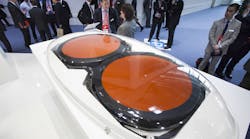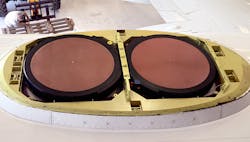Mechanically Phased Array Antennas Provide In-Flight Broadband
Gogo Inc. recently completed a series of flight tests with its Ku-band satellite technology, part of its new wireless broadband system for commercial aircraft, which delivers high data rates to passengers traveling not only over the equator, but also in higher latitudes. The tests validated the coordinated pair of mechanically phased array antennas that serve as the foundation of the system.
The new technology is significant because it accounts for the disadvantages of electronically and mechanically steered antennas that have been traditionally used to provide broadband service to airlines. Gogo’s technology, 2Ku, is built around two beam-forming antennas: one designated for transmitting data, and another for receiving signals from more than 180 compatible Ku-band satellites. The company says that that the dual antennas are symmetrical in design and, because of their large aperture area, have significantly higher spectral efficiency than other in-flight broadband antennas.
The antennas were designed by ThinKom, an antenna design company based in Torrance, Calif. that provides technology for aerospace and other mobile communications. The antennas are unique in that they create beams by mechanically rotating a series of internal plates with precise resonance characteristics. Although the internal disks are moved mechanically, the antennas are not pointed directly at the satellites. Instead, slight changes in the plate position adjust the scan angle in elevation and azimuth direction, according to a patent filing from ThinKom.
The antennas themselves are based on Variable Inclination Continuous Transverse (VICTS) arrays. VICTS were first developed by Raytheon Corp. with research support from ThinKom, MIT, and the Air Force Electronic Systems Center in 2006. The ThinKom version “involves the simple rotation (common and differential) of two coplanar plates, one comprised of a one-dimensional lattice of continuously radiating stubs, and the second one comprised of one or more static line sources,” according to a white paper published by Gogo and ThinKom.
What separates the 2Ku system from more conventional aerospace antennas is that it combines technical benefits from both electronic phased arrays and mechanically steered antennas (including reflectors and flat panels). Like electronic phased arrays, the 2Ku antennas support the highest data rates over the equatorial region, where the maximum area of the antenna plate is facing the satellite. In contrast, flat panel and reflector antennas struggle with interference caused by high skew angles near the equator. They are forced to compensate for this interference by lowering their transmit power, which reduces data rates to the aircraft.
On the other hand, however, mechanically steered antennas are able to provide better broadband service at higher latitudes than electronic phased arrays, which typically have lower data rates in these regions. Because of the mechanically-steered nature of its rotating plates, 2Ku antennas have similar capabilities as flat panel and reflector antennas at high latitudes.
Nevertheless, antenna gain will inevitably fall as the aircraft moves toward these higher latitudes. “Passengers will notice speeds degrade as they reach the Arctic Circle, and the system will not work over the North Pole, Gogo CEO Michael Small said in an article from Aviation Week magazine.
Operating over the 10.7 to 14.5 GHz range, the 2Ku technology can achieve peak data rates up to 70 Mbit/s for the downlink and 15 Mbit/s for the uplink. When spot-beam satellites become available, such as Intelsat’s EpicNG and Telesat’s Telestar 12 VANTAGE, the system is expected to reach peak data speeds of up to 100 Mbits/s.
According to a ThinKom datasheet on its ThinAir Falcon-Ku3030 (the same antenna used in the 2Ku system), the transmit power spectral density ranges from 15 to 18 dBW/4 kHz at the equator (roughly to within 35 deg. north or south). The G/T is typically around 15 to 18 dB/K and 12 dB/K at 20 deg. elevation. The EIRP has been clocked around 51 to 54 dBW and 49 dBW at 20 deg. elevation.
Because of the antenna’s performance in the mid-latitudes and low-profile design, ThinKom’s technology is in high demand within the aviation industry. Gogo has apparently placed an order with ThinKom for more than 500 antenna units. Gogo says that eight airlines representing more than 550 aircraft have agreed either to trial or implement the 2Ku technology, according to a news release.

